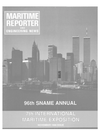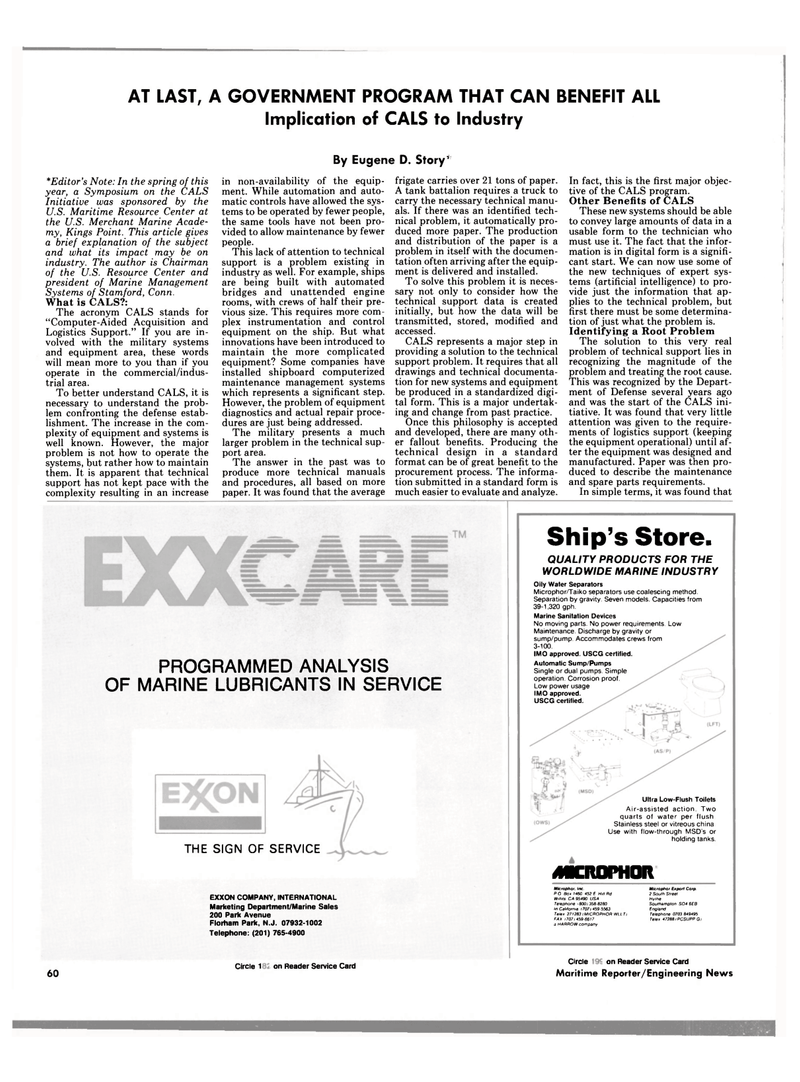
Page 58: of Maritime Reporter Magazine (November 1988)
Read this page in Pdf, Flash or Html5 edition of November 1988 Maritime Reporter Magazine
AT LAST, A GOVERNMENT PROGRAM THAT CAN BENEFIT ALL
Implication of CALS to Industry
By Eugene D. Story* *Editor's Note: In the spring of this year, a Symposium on the CALS
Initiative was sponsored by the
U.S. Maritime Resource Center at the U.S. Merchant Marine Acade- my, Kings Point. This article gives a brief explanation of the subject and what its impact may be on industry. The author is Chairman of the U.S. Resource Center and president of Marine Management
Systems of Stamford, Conn.
What is CALS?:
The acronym CALS stands for "Computer-Aided Acquisition and
Logistics Support." If you are in- volved with the military systems and equipment area, these words will mean more to you than if you operate in the commercial/indus- trial area.
To better understand CALS, it is necessary to understand the prob- lem confronting the defense estab- lishment. The increase in the com- plexity of equipment and systems is well known. However, the major problem is not how to operate the systems, but rather how to maintain them. It is apparent that technical support has not kept pace with the complexity resulting in an increase in non-availability of the equip- ment. While automation and auto- matic controls have allowed the sys- tems to be operated by fewer people, the same tools have not been pro- vided to allow maintenance by fewer people.
This lack of attention to technical support is a problem existing in industry as well. For example, ships are being built with automated bridges and unattended engine rooms, with crews of half their pre- vious size. This requires more com- plex instrumentation and control equipment on the ship. But what innovations have been introduced to maintain the more complicated equipment? Some companies have installed shipboard computerized maintenance management systems which represents a significant step.
However, the problem of equipment diagnostics and actual repair proce- dures are just being addressed.
The military presents a much larger problem in the technical sup- port area.
The answer in the past was to produce more technical manuals and procedures, all based on more paper. It was found that the average frigate carries over 21 tons of paper.
A tank battalion requires a truck to carry the necessary technical manu- als. If there was an identified tech- nical problem, it automatically pro- duced more paper. The production and distribution of the paper is a problem in itself with the documen- tation often arriving after the equip- ment is delivered and installed.
To solve this problem it is neces- sary not only to consider how the technical support data is created initially, but how the data will be transmitted, stored, modified and accessed.
CALS represents a major step in providing a solution to the technical support problem. It requires that all drawings and technical documenta- tion for new systems and equipment be produced in a standardized digi- tal form. This is a major undertak- ing and change from past practice.
Once this philosophy is accepted and developed, there are many oth- er fallout benefits. Producing the technical design in a standard format can be of great benefit to the procurement process. The informa- tion submitted in a standard form is much easier to evaluate and analyze.
In fact, this is the first major objec- tive of the CALS program.
Other Benefits of CALS
These new systems should be able to convey large amounts of data in a usable form to the technician who must use it. The fact that the infor- mation is in digital form is a signifi- cant start. We can now use some of the new techniques of expert sys- tems (artificial intelligence) to pro- vide just the information that ap- plies to the technical problem, but first there must be some determina- tion of just what the problem is.
Identifying a Root Problem
The solution to this very real problem of technical support lies in recognizing the magnitude of the problem and treating the root cause.
This was recognized by the Depart- ment of Defense several years ago and was the start of the CALS ini- tiative. It was found that very little attention was given to the require- ments of logistics support (keeping the equipment operational) until af- ter the equipment was designed and manufactured. Paper was then pro- duced to describe the maintenance and spare parts requirements.
In simple terms, it was found that
PROGRAMMED ANALYSIS
OF MARINE LUBRICANTS IN SERVICE
THE SIGN OF SERVICE
EXXON COMPANY, INTERNATIONAL
Marketing Department/Marine Sales 200 Park Avenue
Florham Park, N.J. 07932-1002
Telephone: (201) 765-4900
Ship's Store.
QUALITY PRODUCTS FOR THE
WORLDWIDE MARINE INDUSTRY
Oily Water Separators
Microphor/Taiko separators use coalescing method.
Separation by gravity Seven models. Capacities from 39-1.320 gph.
Marine Sanitation Devices
No moving parts. No power requirements. Low
Maintenance. Discharge by gravity or sump/pump. Accommodates crews from 3-100.
IMO approved. USCG certified.
Automatic Sump/Pumps
Single or dual pumps. Simple operation. Corrosion proof.
Low power usage
IMO approved.
USCG certified.
Ultra Low-Flush Toilets
Air-assisted action Two quarts of water per flush
Stainless steel or vitreous china
Use with flow-through MSD's or holding tanks.
AKItDPHOIt
Mtcrophor. Inc.
PO Box 1460 452 E Hill Rd
Willits. CA 95490 USA
Telephone <800/358-8280
In California (707) 459-5563
Telex 271283 (MICROPHOR WLL Ti
FAX 17071 459-6617 a HARROW company
Mlcrophor Export Corp. 2 South Street
Hylhe
Southampton. S04 6EB
England
Telephone 0703 849495
Telex 472881PCSUPP G) 60
Circle 321 on Reader Service Card Circle 322 on Reader Service Card Maritime Reporter/Engineering News

 57
57

 59
59
